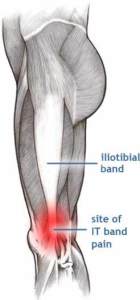What is it?
The ITB is a thick band of fascia which tracks from the outside border of the knee, up over the hip bone, and joins into muscles on the outside of the pelvis.
The band is a key stabiliser of the knee during running.
ITB syndrome is an inflammation of the ITB – most commonly at it’s attachment on the outside of the knee.
What causes it?
ITB syndrome may be the result of several factors. The main causes are poor training habits, anatomical differences and muscular imbalances.
The inflammation often occurs in long distance runners; who repeatedly bend and straighten their legs whilst jogging. As the leg bends and straightens, the ITB moves over the lateral femoral condyle (the outside of the thigh bone at the knee) and can cause irritation.
| Training Habits | Anatomical Differences | Muscular Imbalances |
| Poor warm up/cool down | Increased valgus knee angle | Weak gluteus medius/ hip abductors |
Angled knee due to:
|
Over-pronated feet when running
|
Weak core muscles |
| Breast stroke swimming | Dropped arches or high arches | Uneven stretching of band, e.g. sitting cross legged lots, sleeping on one side with other leg dropped over |
| Resting outside of knee against something repeatedly, e.g.: car door, desk | Leg length discrepancies | |
| Running with an injury on the other leg; compensatory reactions | Bowlegs |
What does it feel like?
Often mis-diagnosed as injury to the knee joint, a stinging pain is felt where the band inserts into the outside of the knee. Other symptoms include pain or tight sensation up the whole ITB, and sometimes swelling.
Generally, pain is felt after an activity, e.g. after a run, or when you twist your knee if turning a corner. Pain is not always felt during an activity and may increase over time.
How is it diagnosed?
Pain at the ITB insertion and along the ITB are good indicators, and there are some simple tests that we can do to confirm this as the cause of your pain. The next step is to determine the reason that your ITB is being overloaded, resulting in the inflammation. This will require further assessment of your strength, flexibility and biomechanics.
How can Back in Action help?
If you think you may have ITB syndrome you will need to see a Physiotherapist who will assess you to establish the reason you’re getting ITB pain. The cause of your symptoms will guide your treatment and may include massage, mobilisations, stretches and strengthening work. Whilst you are waiting for an appointment modify your exercise routine so as not to make the injury any worse, ice the area that is painful and see your local pharmacist for pain relief medication. Gentle stretching and use of the foam roller can also help.

